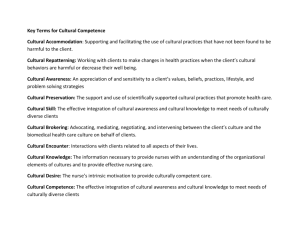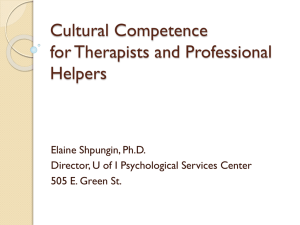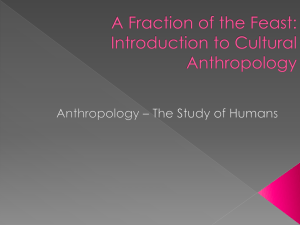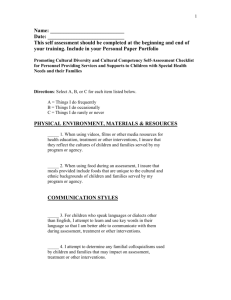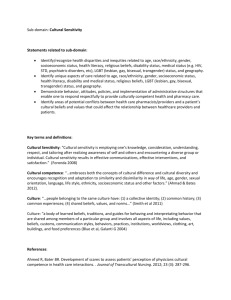Printable Lecture Notes
advertisement
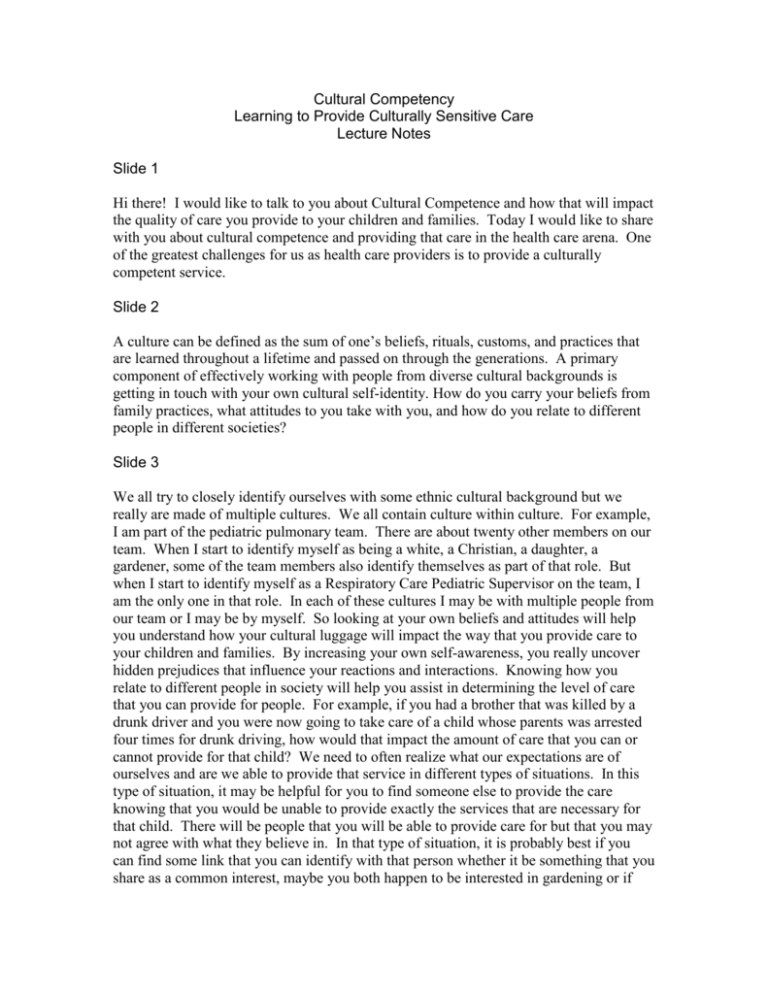
Cultural Competency Learning to Provide Culturally Sensitive Care Lecture Notes Slide 1 Hi there! I would like to talk to you about Cultural Competence and how that will impact the quality of care you provide to your children and families. Today I would like to share with you about cultural competence and providing that care in the health care arena. One of the greatest challenges for us as health care providers is to provide a culturally competent service. Slide 2 A culture can be defined as the sum of one’s beliefs, rituals, customs, and practices that are learned throughout a lifetime and passed on through the generations. A primary component of effectively working with people from diverse cultural backgrounds is getting in touch with your own cultural self-identity. How do you carry your beliefs from family practices, what attitudes to you take with you, and how do you relate to different people in different societies? Slide 3 We all try to closely identify ourselves with some ethnic cultural background but we really are made of multiple cultures. We all contain culture within culture. For example, I am part of the pediatric pulmonary team. There are about twenty other members on our team. When I start to identify myself as being a white, a Christian, a daughter, a gardener, some of the team members also identify themselves as part of that role. But when I start to identify myself as a Respiratory Care Pediatric Supervisor on the team, I am the only one in that role. In each of these cultures I may be with multiple people from our team or I may be by myself. So looking at your own beliefs and attitudes will help you understand how your cultural luggage will impact the way that you provide care to your children and families. By increasing your own self-awareness, you really uncover hidden prejudices that influence your reactions and interactions. Knowing how you relate to different people in society will help you assist in determining the level of care that you can provide for people. For example, if you had a brother that was killed by a drunk driver and you were now going to take care of a child whose parents was arrested four times for drunk driving, how would that impact the amount of care that you can or cannot provide for that child? We need to often realize what our expectations are of ourselves and are we able to provide that service in different types of situations. In this type of situation, it may be helpful for you to find someone else to provide the care knowing that you would be unable to provide exactly the services that are necessary for that child. There will be people that you will be able to provide care for but that you may not agree with what they believe in. In that type of situation, it is probably best if you can find some link that you can identify with that person whether it be something that you share as a common interest, maybe you both happen to be interested in gardening or if you have an interest in maybe you have a child that is also the same age as their child. That will help you connect with them so that you have something in common. Slide 4 Keep in mind that all of your manners and customs are so natural to you that you seldom realize that they are part of your own culture. Your interactions influence your culture. Your culture gives direction and meaning into your life experiences and it gives you rules about your health and how you deal with coping. The goals of providing cultural care are to maintain the child and family’s culture as best possible and adapt or re-pattern harmful health practices. Slide 5 Acculturation is a term which is used to describe people from a particular culturalist behavior which is more like the American norm. The degree to which people act like mainstream America is related to how much exposure that they have had to the dominant standards and behaviors. Slide 6 There are a lot of factors that will lead to higher degrees of acculturation. Some of the factors are education; parents want their children to succeed in this culture, they view education as an important step in obtaining higher goals. Many of them would like their children to reach higher levels of education and many are very comfortable with them just receiving high school education. Employment is important; what company they work for, what socioeconomic status they hold. Oftentimes people that come to America leaving their home country may have had a high status paying position or a high role in their home country and now end up working in a factory here just to provide resources for their family. Language; what kind of language is used in the home versus in the community? Oftentimes English is a secondary language that is used in the home so families want their children to be able to speak the ethnic language and maintain some of their cultural background. The time in the community is important; the longer that families live in the United States, the more they become acculturated to the United States. Family members may have arrived at different times; it may be important to them if they live in a rural setting versus an urban setting. Why do they come to the United States? Were there other family members that had migrated here before them? Maybe they needed to leave their home country because it was extreme financial difficulties or maybe there was political involvement that they were uncomfortable with or religious discrimination. The age of family members at the time of immigration whether the children were at school age or if they were influenced by their grandparents. History of cultural groups in the community; how long has the cultural group been in the community as a unit? Is there one person in the cultural group or has there been multiple people in the cultural group? How involved are they in their cultural group is another important factor. What ties do they have with family members? Is there extensive contact with people outside of the community or are they pretty much centrally located within the community themselves? There are also many other factors that help influence acculturation such as the age, sex, occupation, social class, religious affiliation, health beliefs, holidays and special events. So when working with people it is really important to understand how they have acculturated into mainstream America and what traditional or ethnic beliefs they have continued to keep with them. Slide 7 Many of our children and family that we see have actually assimilated. They have left the culture of origin behind and they are now practicing traits from another culture. To assume that someone practices their beliefs from a particular culture can be very harmful. As the weight of each culture is measured there is a uniqueness about each person that we need to appreciate. Slide 8 This is where we really need to be careful. Our biases and assumptions can be both helpful and harmful. They help us to develop belief systems as well as cloud our thinking. When they cloud our thinking, that is when they cause problems such as stereotyping, prejudices or racism. Many times people over-generalize simply because they do not have correct information. We all make generalizations as a the way of framing our world or environment which is very different from stereotyping. Stereotyping occurs when you receive the correct information and you are unable or unwilling to exchange that information from previously held generalizations. You should never enter a relationship with an assumption about an individual based on their looks, the spelling of their last name, or the location that they live in. To understand a person’s cultural background, you need to ask them about their beliefs. Each person is different and may not follow the traditional beliefs of their ethnic cultural group. Differences amongst people should really be viewed as a positive and a valuable aspect to individual growth and development. Valuing an individual demands attention to these differences. If people feel that their differences make up an essential part of their worth, then they feel like they are valued and they are viewed at their fullest both as an individual and as a group. It is important for health care providers and the family to develop a mutual trust and respect. Slide 9 For many it may be difficult to talk about the problems or concerns that they have so asking questions will help you understand the situation better. Here are examples of some questions that I suggest you ask to help better understand the situation. In order to provide better medical care, what do we need to know about your culture or family traditions? Who takes care of your child when he or she is ill? Are we doing anything that makes you or anyone in your family uncomfortable? Do you have trouble getting prescriptions filled? Slide 10 There are some common elements required with cultural competence. The first is communication. A commitment to mutual communication is based on four assumptions. They are recognition and value of human dignity, cultural relativism is an acceptable and preferred condition, willingness to alter personal behavior and response to the communication process, willingness to decrease personal resistance and defensiveness. The expectations that the team has for the child and family needs to be clearly defined. It is also important that you understand that the child and family has expectations as well. Asking questions will also help you understand their goals. For example, it may be an expectation of the team that little Lily learns how to hold a spoon but the family has an expectation that she learn to hold chopsticks. Understanding the expectations will foster working toward the common goal. Slide 11 Another common element required with cultural competence is listening to the child and family and being empathetic. It is very important to have good listening skills. In our hurried society that we live in, it is easy to not listen and focus in what our goal is not on what the child and family are telling us. Or we may only listen to key words and not hear the rest of the message. Showing empathy validates to the family and child that they are being heard and understood. This will also provide feedback with sensitivity to individual differences. It is helpful in developing trust to validate individual feelings. Slide 12 So what model of cultural competence do I use? It seems that every discipline has developed models of cultural competence systems. When creating your own, you want to search different models from all disciplines and create your own that will best serve your families and the environment that you work in. Slide 13 There are three key points to remember when creating a culturally competent system. One, encourage families to be the primary care provider for their child. Two, recognize families will make decisions based on their cultural beliefs. And three, understand that cultural minority families will blend their beliefs with the dominant culture that they live in. Understanding cultural competence enables you to become a more effective care provider. Slide 14 The ability to care for children and families of varying cultures is of value. Becoming culturally competent is an ongoing process that you will develop as you continue to work in your health care profession. Please feel free to contact me if you have any further questions.
